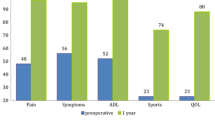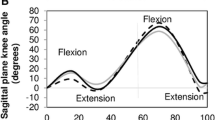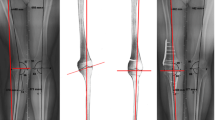Abstract
Introduction
Medial opening wedge high tibial osteotomy (HTO) is used to treat medial compartment osteoarthritis (OA) of the knee. HTO shifts the weight-bearing line from the medial compartment into the lateral compartment. The aim of this study was to investigate the functional biomechanical consequences of this alteration in alignment.
Methods
Eleven male patients with medial compartment osteoarthritis underwent three-dimensional gait analysis during level walking before 12 months and after medial opening wedge HTO. Nine male control subjects of a similar age were also tested using the same protocol. Sagittal and coronal angles and moments in both operated and non-operated knees were compared. Pre and postoperative radiographic coronal plane alignment was also measured.
Results
Walking speed increased significantly postoperatively (P = 0.0001) and was not different from controls. Preoperatively, maximum knee flexion in stance was reduced compared to control (P = 0.02). Postoperatively, maximum knee flexion increased significantly (P = 0.005) and was the same as the controls. Similar changes were observed for the maximum knee flexion moment. The mean maximum varus angle during stance was reduced from 13.5° preoperatively to 5.4° postoperatively (P = 0.0001) compared to (6.8°) in controls. The mean maximum adduction moment also reduced from 3.9 to 2.7 (% Bw/ht, P = 0.02), compared to 3.6 in control subjects. Interestingly, the adduction moments in the non-operated knee increased postoperatively from 3.3 to 4.1 (% Bw/ht, P = 0.02). The mean radiological mechanical alignment was changed from 172 degrees preoperatively to 180 degrees postoperatively (P < 0.001).
Conclusion
HTO resulted in normalisation of several dynamic knee function parameters such as walking speed, knee flexion and external knee flexion moment. As anticipated, HTO reduced the varus angle and adduction moments of the operated knee. An increased adduction moment in the non-operated knee over the first postoperative year was found.
Level of evidence
Prospective case–control clinical laboratory study, Level III.




Similar content being viewed by others
References
Aglietti P, Buzzi R, Vena LM, Baldini A, Mondaini A (2003) High tibial valgus osteotomy for medial gonarthrosis: a 10- to 21-year study. J Knee Surg 16:21–26
Andriacchi TP, Lang PL, Alexander EJ, Hurwitz DE (2000) Methods for evaluating the progression of osteoarthritis. J Rehabil Res Dev 37:163–170
Andriacchi TP, Mundermann A, Smith RL, Alexander EJ, Dyrby CO, Koo S (2004) A framework for the in vivo pathomechanics of osteoarthritis at the knee. Ann Biomed Eng 32:447–457
Birmingham TB, Giffin JR, Chesworth BM, Bryant DM, Litchfield RB, Willits K, Jenkyn TR, Fowler PJ (2009) Medial opening wedge high tibial osteotomy: a prospective cohort study of gait, radiographic, and patient-reported outcomes. Arthritis Rheum 61:648–657
Birmingham TB, Hunt MA, Jones IC, Jenkyn TR, Giffin JR (2007) Test-retest reliability of the peak knee adduction moment during walking in patients with medial compartment knee osteoarthritis. Arthritis Rheum 57:1012–1017
Briem K, Ramsey DK, Newcomb W, Rudolph KS, Snyder-Mackler L (2007) Effects of the amount of valgus correction for medial compartment knee osteoarthritis on clinical outcome, knee kinetics and muscle co-contraction after opening wedge high tibial osteotomy. J Orthop Res 25:311–318
Brinkman JM, Lobenhoffer P, Agneskirchner JD, Staubli AE, Wymenga AB, van Heerwaarden RJ (2008) Osteotomies around the knee: patient selection, stability of fixation and bone healing in high tibial osteotomies. J Bone Joint Surg Br 90:1548–1557
Coventry MB (1979) Upper tibial osteotomy for gonarthrosis. The evolution of the operation in the last 18 years and long term results. Orthop Clin North Am 10:191–210
Davis RB (1997) Reflections on clinical gait analysis. J Electromyogr Kinesiol 7:251–257
Dugdale TW, Noyes FR, Styer D (1992) Preoperative planning for high tibial osteotomy. The effect of lateral tibiofemoral separation and tibiofemoral length. Clin Orthop Relat Res 274:248–264
Hernigou P, Medevielle D, Debeyre J, Goutallier D (1987) Proximal tibial osteotomy for osteoarthritis with varus deformity. A ten to thirteen-year follow-up study. J Bone Joint Surg Am 69:332–354
Hunt MA, Birmingham TB, Bryant D, Jones I, Giffin JR, Jenkyn TR, Vandervoort AA (2008) Lateral trunk lean explains variation in dynamic knee joint load in patients with medial compartment knee osteoarthritis. Osteoarthritis Cartilage 16:591–599
Ivarsson I, Myrnerts R, Gillquist J (1990) High tibial osteotomy for medial osteoarthritis of the knee. A 5 to 7 and 11 year follow-up. J Bone Joint Surg Br 72:238–244
Kadaba MP, Ramakrishnan HK, Wootten ME (1990) Measurement of lower extremity kinematics during level walking. J Orthop Res 8:383–392
Kendoff D, Lo D, Goleski P, Warkentine B, O’Loughlin PF, Pearle AD (2008) Open wedge tibial osteotomies influence on axial rotation and tibial slope. Knee Surg Sports Traumatol Arthrosc 16:904–910
Machner A, Pap G, Krohn A, Rohkohl K, Awiszus F (2002) Quadriceps muscle function after high tibial osteotomy for osteoarthritis of the knee. Clin Orthop Relat Res 399:177–183
McMahon M, Block JA (2003) The risk of contralateral total knee arthroplasty after knee replacement for osteoarthritis. J Rheumatol 30:1822–1824
Mundermann A, Dyrby CO, Hurwitz DE, Sharma L, Andriacchi TP (2004) Potential strategies to reduce medial compartment loading in patients with knee osteoarthritis of varying severity: reduced walking speed. Arthritis Rheum 50:1172–1178
Noyes FR, Goebel SX, West J (2005) Opening wedge tibial osteotomy: the 3-triangle method to correct axial alignment and tibial slope. Am J Sports Med 33:378–387
Ozalay M, Ozkoc G, Circi E, Akpinar S, Hersekli MA, Uysal M, Cesur N (2008) The correlation of correction magnitude and tibial slope changes following open wedge high tibial osteotomy. Knee Surg Sports Traumatol Arthrosc 16:948–951
Parker RD (2005) Valgus-producing opening wedge proximal tibial osteotomy: what, when, and how. Orthopedics 28:977–979
Prodromos CC, Andriacchi TP, Galante JO (1985) A relationship between gait and clinical changes following high tibial osteotomy. J Bone Joint Surg Am 67:1188–1194
Ramsey DK, Snyder-Mackler L, Lewek M, Newcomb W, Rudolph KS (2007) Effect of anatomic realignment on muscle function during gait in patients with medial compartment knee osteoarthritis. Arthritis Rheum 57:389–397
Rinonapoli E, Aglietti P, Mancini GB, Buzzi R (1988) High tibial osteotomy in the treatment of arthritic varus knee. A medium term (small) review of 61 cases. Ital J Orthop Traumatol 14:283–292
Sharma L (2007) The role of varus and valgus alignment in knee osteoarthritis. Arthritis Rheum 56:1044–1047
Sharma L, Lou C, Felson DT, Dunlop DD, Kirwan-Mellis G, Hayes KW, Weinrach D, Buchanan TS (1999) Laxity in healthy and osteoarthritic knees. Arthritis Rheum 42:861–870
Wada M, Imura S, Nagatani K, Baba H, Shimada S, Sasaki S (1998) Relationship between gait and clinical results after high tibial osteotomy. Clin Orthop Relat Res 354:180–188
Whitehead TS, Willits K, Bryant D, Giffin JR, Fowler PJ (2009) Impact of medial opening or lateral closing tibial osteotomy on bone resection and posterior cruciate ligament integrity during knee arthroplasty. J Arthroplasty 24:979–989
Zhao D, Banks SA, Mitchell KH, D’Lima DD, Colwell CW Jr, Fregly BJ (2007) Correlation between the knee adduction torque and medial contact force for a variety of gait patterns. J Orthop Res 25:789–797
Author information
Authors and Affiliations
Corresponding authors
Rights and permissions
About this article
Cite this article
Lind, M., McClelland, J., Wittwer, J.E. et al. Gait analysis of walking before and after medial opening wedge high tibial osteotomy. Knee Surg Sports Traumatol Arthrosc 21, 74–81 (2013). https://doi.org/10.1007/s00167-011-1496-y
Received:
Accepted:
Published:
Issue Date:
DOI: https://doi.org/10.1007/s00167-011-1496-y




